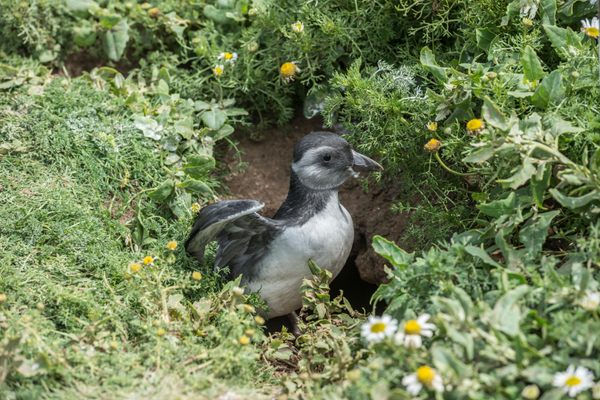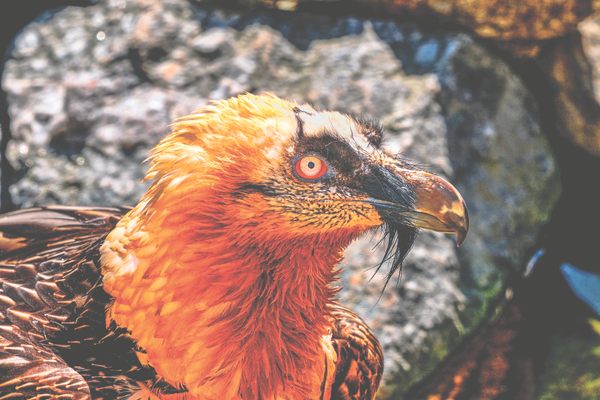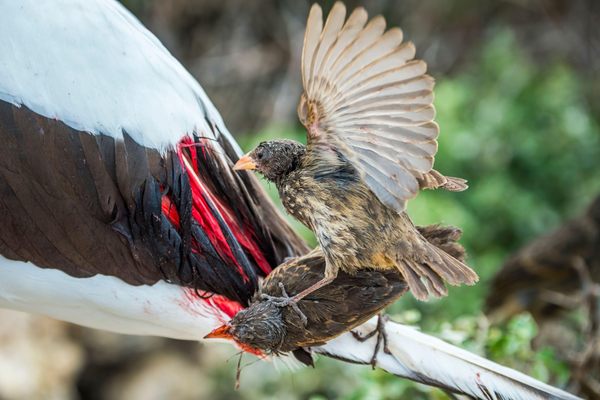How an Army of ‘Stork Sisters’ Protects Assam’s Endangered, Muppet-like Birds
Greater adjutants may look straight out of “The Dark Crystal,” but they play an important role in cleaning their environment.
Each week, Atlas Obscura is providing a new short excerpt from our upcoming book, Wild Life: An Explorer’s Guide to the World’s Living Wonders (September 17, 2024).
Like most dump sites, the Boragaon landfill in Guwahati, Assam, is an overwhelming place, made up of ever-shifting piles of colorful trash.
Unlike most dump sites, the Boragaon is overseen by a platoon of enormous, Muppet-like endangered storks known as greater adjutants. Nearly 5 feet (1.5 m) tall, with striking ice-blue eyes and large wedge-like bills, any greater adjutant could easily star in a punk rock version of Sesame Street. The skin of their bare Technicolor necks ranges from yellow to red orange, depending on the individual and breeding season. Each has a crinkly, inflatable pouch hanging at the base of the neck, the purpose of which remains unknown.
In Assamese, greater adjutants are called hargilas, or “bone swallowers,” after their greatest skill—horking down large chunks of food. Though they primarily scavenge on carrion, they will gladly eat vertebrates such as fish and can even swallow ducks in one gulp. At the landfill, they strut around on top of the trash, plucking morsels from the piles and occasionally stretching out their 8-foot (2.4 m) wings to soar upward on thermals. If they get too hot, they defecate on their own legs, a strategy called urohidrosis.
Greater adjutants are some of the world’s rarest storks—an estimated 800 to 1,200 individuals remain worldwide. For a long time, their habits and appearance gave the birds a reputation as “a bad omen and a carrier of diseases,” says biologist Purnima Devi Barman. Persecution and habitat destruction, including draining of wetlands and loss of nesting trees, brought down their numbers.

In 2007, Barman founded a grassroots greater adjutant conservation group, the Hargila Army, that operates in villages in Assam. Through community conservation efforts—from incorporating hargila motifs into traditional Assamese textiles to educating people about the storks’ role as vital links in the ecosystem—the Hargila Army has managed to more than double the local population of greater adjutants. Barman even does impromptu educational events at the landfill, helping people better appreciate the power of the birds who spend their time there.
Range: More than 80 percent of the world’s greater adjutants live in Assam, India. The rest are found in Cambodia and Bihar, India.
Species: Greater adjutant (Leptoptilos dubius), or hargila
How to see them: Look for greater adjutants scavenging at the Boragaon landfill in Guwahati. A short distance away, you can spot them high up in their nesting trees in the villages of Dadara, Pachiria, and Singimari, in the Kamrup District. The two sites have the highest concentrations of these storks in the world.
THE WILD LIFE OF: A Hargila Baideo/Stork Sister
Purnima Devi Barman is a wildlife biologist and the founder of the Hargila Army, an all-female conservation team in Assam, India. Her innovative community-led approach has successfully involved rural homemakers in conservation and has vastly increased the number of local storks and stork nests.
What inspired you to help greater adjutants?
My bond with nature was fostered early on by my grandmother, who always pointed out storks and vultures to me. One day, when my children were two and a half years old, I witnessed a man cutting down a nesting tree, causing baby greater adjutants to fall.
The sight of these helpless baby birds resonated, and I felt a deep connection, viewing them akin to my own children. Seeing them in distress and being referred to as bad omens was heart-wrenching. Holding my children that night, I realized my PhD wouldn’t mean much if these birds continued to be mistreated.
How does the Hargila Army work?
The Hargila Army is a rural, all-women grassroots movement. When I began, I didn’t have a detailed plan. But once I befriended the local women and heard how the hargila is considered a bad omen, I felt it needed to be part of our tradition and culture.
When a woman pledges to be a part of the Hargila Army, her role extends to educating her husband about it. So, while it’s a women-led initiative, we work with everyone. Through the Hargila Army, rural women get a voice. They show the world and our society that a so-called “bad omen” can become a cultural symbol.

How does the community help to directly support greater adjutants?
Greater adjutants are colonial nesting birds that prefer certain trees for breeding, often returning to the same ones year after year. Our motto is to protect the trees to save the birds—protect the backyard, protect the biodiversity. If you come, you’ll see the coexistence: greater adjutants nesting in trees and people working and living nearby. We’ve put nets under nesting trees to catch greater adjutant fledglings that fall.
Our communities, especially our women, also throw baby showers for greater adjutants, similar to how we celebrate for expecting mothers. Once we initiated this, it became a massive movement. This and other events, like integrating the birds into our folk songs and traditions, show our connection and commitment.
How else have the greater adjutants been integrated into your culture?
Women are vital carriers of our culture. While many viewed the hargila as a bad omen or even ugly, based on various perceptions, I always believed the opposite. I felt the hargila should be seen as beautiful and fashionable. To change these perceptions, we thought of celebrating its beauty through our traditions—weaving the hargila into fabrics.
The turning point was when we incorporated the hargila into the gamosa, an integral part of our Assamese tradition. It’s a cloth we hold in high regard, used in rituals, to welcome guests, and during prayers. Weaving the hargila into the gamosa made people appreciate the bird more.
Additionally, we began weaving hargila motifs into our traditional mekhela chadors. It became a fashion statement, merging our passion with fashion. Now, we even sell these weavings. People love creativity, and when they saw the hargila woven into our traditional attire, it resonated with many.
What do you wish the world knew about the hargila and other lesser- known species?
These birds, often viewed as bad omens, play a vital role as cleaners. They scavenge, purifying our environment. They are working so much for us. What I’ve learned from hargila is they are swallowing all the pains and negativity, but they are ultimately spreading positivity.
Every species, big or small, deserves respect. Our perceptions of beauty and ugliness are just mental constructs. Coexistence is fundamental. We are all interconnected threads in the tapestry of life.
Wild Life: An Explorer’s Guide to the World’s Living Wonders celebrates hundreds of surprising animals, plants, fungi, microbes, and more, as well as the people around the world who have dedicated their lives to understanding them. Pre-order your copy today!



























Follow us on Twitter to get the latest on the world's hidden wonders.
Like us on Facebook to get the latest on the world's hidden wonders.
Follow us on Twitter Like us on Facebook